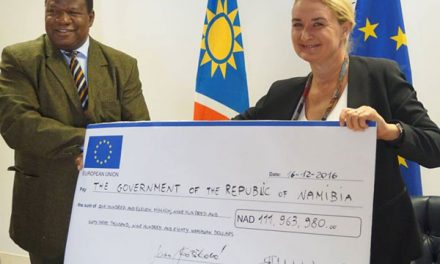
Looking back on SPAN

SPAN’s Project Coordinator, Samson Mulonga. (Photograph by Hilma Hashange)
The Ministry of Environment and Tourism, in collaboration with the United Nations Development Programme (UNDP) and the GEF developed the SPAN project, with the long-term goal of sustainable management of natural resources and to protect biodiversity and contribute to equitable economic and social development. The objective of the project is to increase effective management in the country’s protected areas. The project’s preparatory phase started in 2004, with the full phase implemented in 2006 running until this year.
The project was designed to remove barriers to effective Protected Areas (PA) management such as incomplete coverage of PA network and insufficient park infrastructure by tackling capacity issues at three levels namely; Systematic capacity, Institutional capacity and Field level capacity.
Some of SPAN’s notable achievements include assisting the ministry in the proclamation of new protected areas, financial administration transformation, human resource management strategy development, park management plans and tourism plan development. Other issues included addressing mining in protected areas as well as capacity building of the ministry’s staff and provision of equipment and vehicles.
At systematic capacity level, the project published the Sandpaper, a quarterly park newsletter and organised bi-monthly Park Talks. According to SPAN’s Project Coordinator, Samson Mulonga, Namibia’s protected areas are a heritage for all the citizens. Therefore citizens need to be informed of the issues and opportunities that protected areas present.
It is important to show Namibian citizens and the world at large the work that the park staff is doing on a daily basis. It was therefore imperative that a magazine that profiles the above objectives be created, ‘’ Mulonga said.
As the project neared its end, a Sustainability and Exit Plan was developed to address a smooth handover of activities and project assets to the Ministry of Environment and Tourism to ensure continuity.
For instance, activities like the publication of Sandpaper and the regular Park Talk meetings, will continue
Other activities include linking the Field Staff Awards, which have been in existence since 2007 to award and motivate staff, to the Performance Management System (PMS) and park performance, based on the Namibia Management Effectiveness Tracking Tool (NAMETT). The Incident Book Monitoring System (IBMS), a database system that helps staff to monitor incidents in parks will also be integrated within the ministry’s budget.
Throughout its course, SPAN has been evaluated twice by external evaluators and was rated as highly successful, the highest rating that GEF/UNDP projects can get. The project’s final evaluation retained an overall High Score and led to the project being featured in the GEF Book as one of it’s 20 best GEF initiatives. Mulonga emphasized the significant advancements the country has made in establishing new protected areas and promoting conservation of biodiversity outside of formal state-protected areas .“SPAN being featured as one of GEF’s best achievements will definitely put the country on the map,” said Mulonga. But he said that even though management of natural parks has since improved, there are still challenges ahead that requires more intervention of this nature.












































